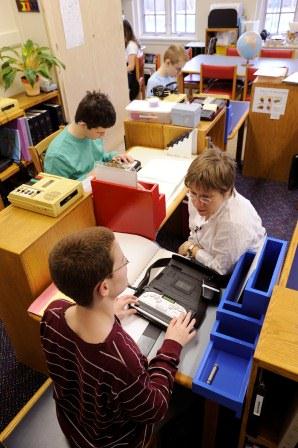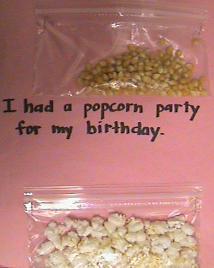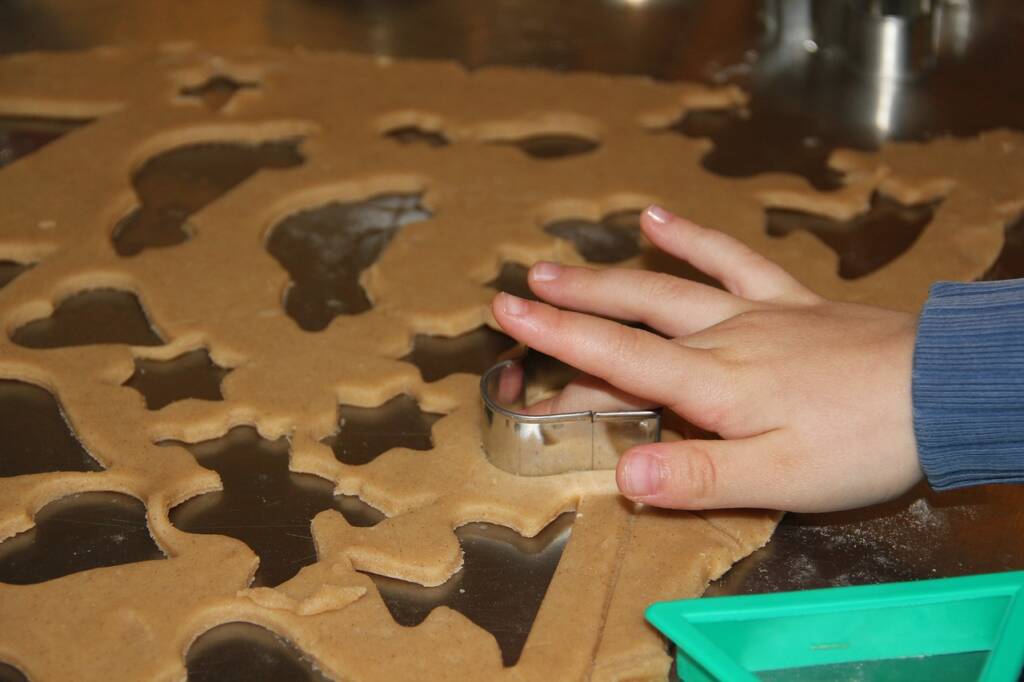- When is a child ready to learn braille?
- How can I teach braille reading and writing?
- What strategies are best for teaching a student to read braille?
- What are the components of a reading program for braille readers?
- What are some of the key considerations when developing a reading program for braille readers?
- Where can I learn more about teaching braille?

When is a child ready to learn braille?
As with children who learn to read print, children who are blind must have broad and repeated exposure to language, concepts, and books before they receive formal instruction in reading. Young children will benefit from being read aloud to, and should have a chance to handle braille books well before they are formally taught to read. In addition to adequate language development, a clear understanding of basic positional concepts, and an interest in books, braille readers must also demonstrate sufficient tactile skills and fine motor coordination. Early literacy and pre-braille skills are essential to success as a braille reader. A child’s educational team and his or her teacher of the blind and visually impaired should work together to determine the best approach for each individual student.
How can I teach braille reading and writing?
Teaching Braille Reading and Writing (Webcast)
In this webcast from Perkins School for the Blind, Lucia Hasty discusses the importance of early literacy, language and concept development for children who are blind and the specific skills needed for braille literacy. In addition, Lucia, who has extensive expertise related to teaching braille reading and writing,shares information regarding the importance of supporting others involved in the process e.g., classroom teachers as well as “best practices” for teachers of the visually impaired.
The webcast presents the following chapters:
- Ch. 1: Introduction
- Ch. 2: Early Exposure to Books and Reading Experiences
- Ch. 3: The Significance of Concept and Oral Language Development
- Ch. 4: Additional Skills Necessary for Braille Literacy
- Ch. 5: Maintaining Currency with the Braille Code
- Ch. 6: Conveying Information in Brailled Formats
- Ch. 7: Supporting the Classroom Teacher
What strategies are best for teaching a student to read braille?
Students will need special instruction to learn to read and write braille code. Usually students are introduced first to the alphabet and uncontracted braille, and once they are proficient in recognizing and producing letters, they move on to contracted braille. There is currently a lot of discussion about when to introduce contractions and whether or not to introduce them at all. You can learn more about this in the article Reading for Everyone: Expanding Literacy Options by Cyral Miller.
What are the components of a reading program for braille readers?
Gayle Flegel, a TVI for Catholic Charities Maine, shares her ideas for suggested components of a reading program for braille readers.
- Language experience stories-written by both the student and the teacher.
- Basal readers: be very selective of only meaningful subjects to ensure comprehension. Can use trade books, story-box books
- Use reading texts or books that sighted peers are using, if possible.
- Introduce vocabulary with flashcards prior to reading the story.
- Use Building on Patterns from APH (American Printing House for the Blind)
- Spelling of vocabulary.
- Tie in with braille contractions as appropriate.
- Use a phonetic component such as Recipe for Reading to ensure good decoding skills.
- Include writing of the stories using the braillewriter or dictating on a recorder.
- TVI can make the decision whether it’s best to introduce uncontracted braille only or contracted from the start.
- May need to include actual experiences with introduction of stories if they are about unfamiliar things. Ex. Going to a laundromat when reading “A Pocket for Corduroy” or an airport if reading about planes. Perhaps the family or the TVI can take the child to recommended places.
- Alphabet containers: Example — a box for the letter “A” could include an abacus, toy alligator, alphabet blocks, animal cracker, rubber ant. Include flashcards of each item using both contracted and uncontracted braille. See Alpha Boxes.
Some Additional Ideas:
- Use smelly stickers or smiley face from APH
- Have comments in braille already made up just like teacher writes on paper for sighted children. Ex. “Good job needs more work”. Can use APH ones and/or make additional ones generated by what classroom teacher would say
- For charts in room or tally sheets; use Wikki-Stix, puffy paint, ask TVI for ideas to adapt. Use Feel ‘n Peel Number Stickers from APH.
- Help only as much as necessary; stress independence
- Teacher does not need to know braille, but visually learning alphabet would be helpful.
THE IMPORTANT THING IS TO INDIVIDUALIZE THE BLIND CHILD’S PROGRAM. NOT ALL THINGS WORK FOR ALL BLIND CHILDREN. THEIR SKILLS AND DEVELOPMENTAL LEVELS VARY RADICALLY.
What are some of the key considerations in developing a reading program for braille readers (Pre-K through 4th grade)?
Gayle Flegel, a TVI for Catholic Charities Maine, shares her ideas of some of the key considerations in developing a reading program.
- Congenitally blind or adventitiously blinded (how long did the child have vision or does he/she still have some vision.)
- Level of concept development-on level with peers?
- Does the child understand reality vs. fantasy?
- Does the child have other developmental delays or concerns such as language/communication (This is often the case with students that are congenitally blind, as well as those who are on the Autism Spectrum.)
- Is the story written about something that the child understands or has experienced or unfamiliar material? Would you understand the concepts and the story-line if you were blind from birth? Read stories about birthday parties, going to the park rather than things they haven’t experienced – outer space and alien, living in an igloo etc.
- Is the vocabulary appropriate for a totally blind child?
- In working with the TVI for the Blind & Visually Impaired to develop an individualized reading program for the blind child, be sure to include his/her language/communication therapist if there is one involved.
- Some estimate as much as 90% of learning is visual, children learn through imitation and exposure. This affects learning to read significantly. The children don’t see words on television, signs in environment such as McDonald’s, parents reading newspapers, seeing print on cereal boxes, milk cartons, etc.
Where can I learn more about teaching braille?
For additional ideas and information about braille instruction, see the following:
Braille Instructional Resources
Texas School for the Blind and Visually Impaired
Checklist of Literary Braille Skills
Instructional Strategies for Braille Literacy
Diane P. Wormsley and Frances Mary D’Andrea, Editors, American Foundation for the Blind (2006)
Chapters include:
- Determining the Reading Medium for Students with Visual Impairments: A Diagnostic Teaching Approach
By Alan J. Koenig and M. Cay Holbrook - How to Make a Braille Wave
By Bonnie Simons - Teaching Specific Concepts to Visually Handicapped Students
By Amanda Hall - Reading Comes Naturally: A Mother and Her Blind Child’s Experiences
By Diane D. Miller - Using an Integrated Literacy Curriculum with Beginning Braille Readers
By Anna M. Swenson - A Process Approach to Teaching Braille Writing at the Primary Level
By Anna M. Swenson - Teaching Braille Reading to Students with Low Vision
By M. Cay Holbrook and Alan J. Koenig
Literacy in Your Classroom: Supporting General Education Teachers of Braille-Reading Students
PRCVI — Provincial Resource Centre for the Visually Impaired
The Provincial Resource Centre for the Visually Impaired has developed a learning module designed to help classroom teachers working with braille reading students. You will find both general and specific information to help you work with a student who reads braille in your classroom.
ONE is FUN — A Teaching Guide for Introducing Braille to Kids
by Marjorie Troughton
Special Needs Opportunity Window, Ontario



